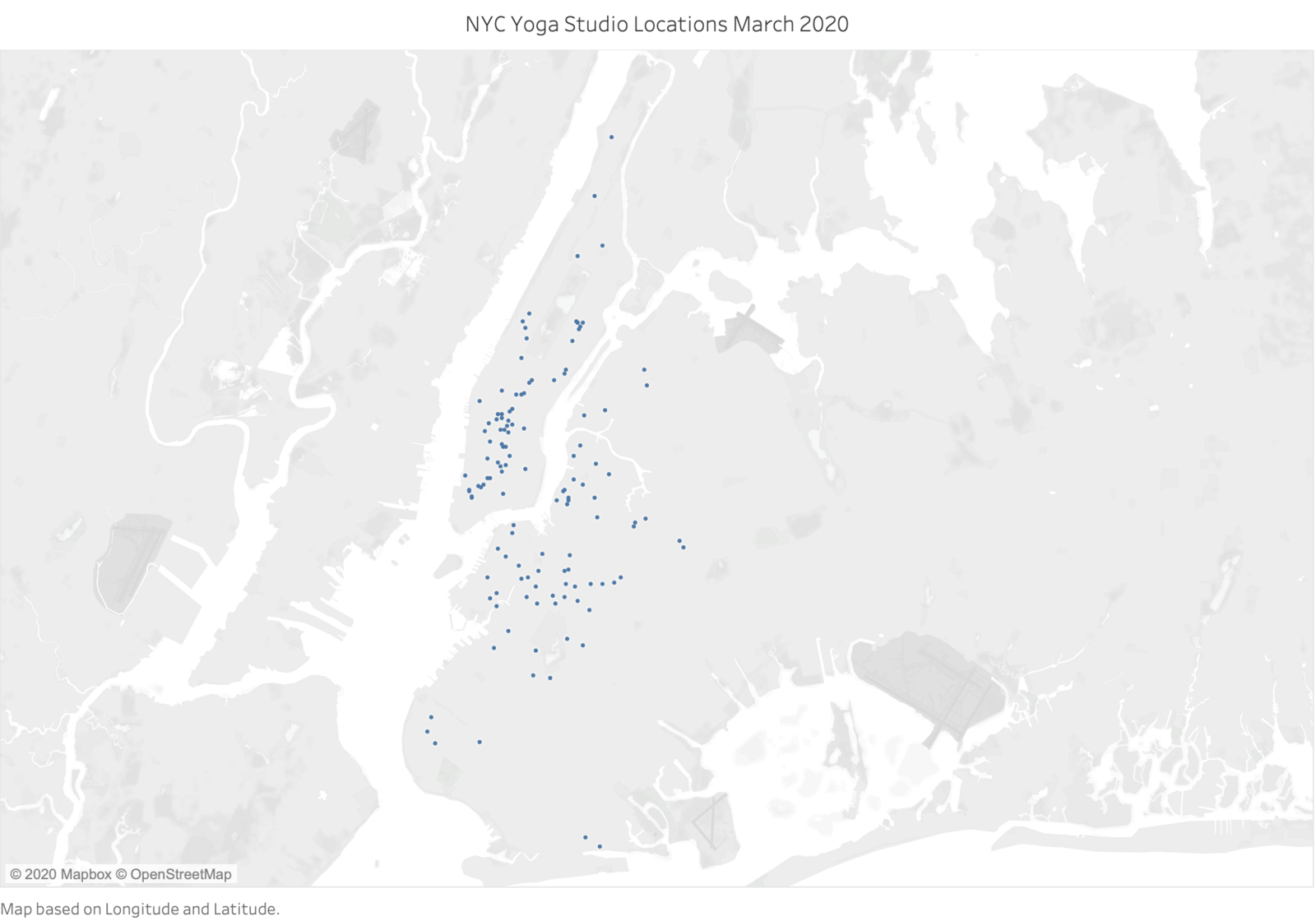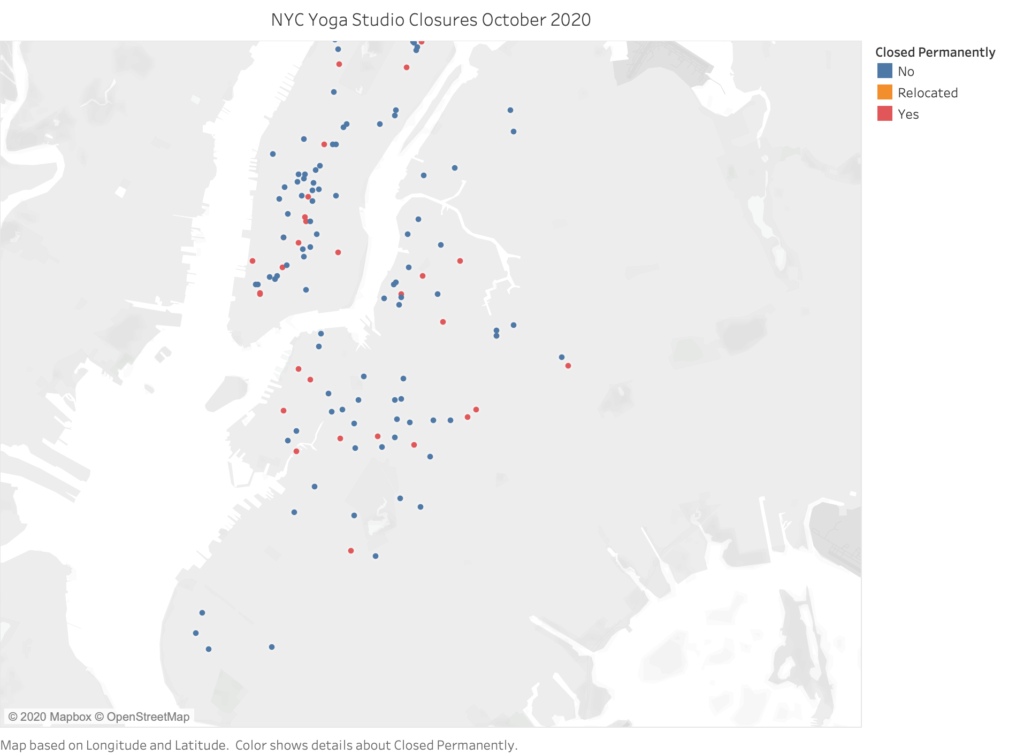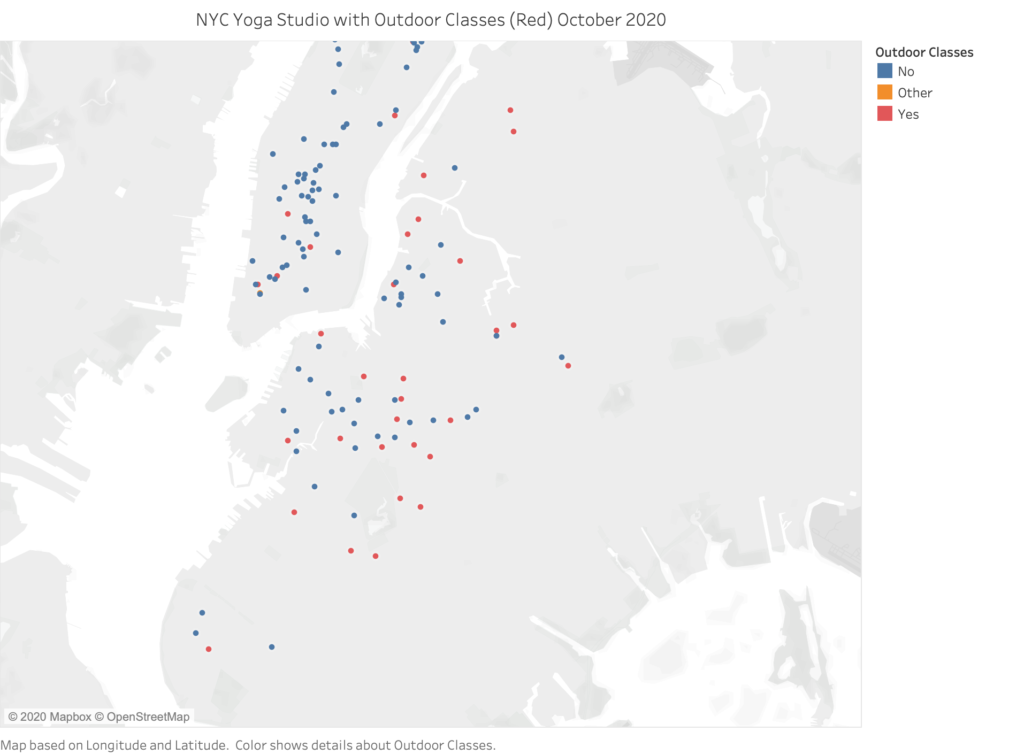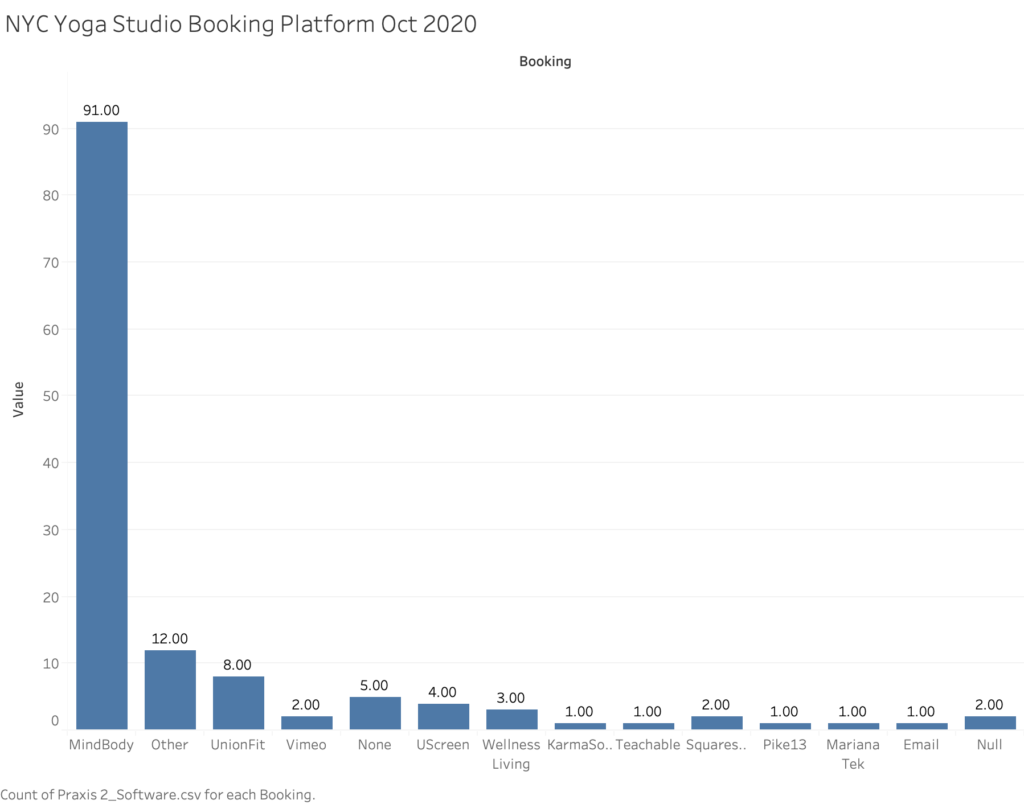As an NYC yoga studio instructor, I thought it might be a little bit depressing but also therapeutic to map out the structures themselves for our first mapping assignment, as sort of an honor or remembrance to what was. While gathering the initial latitude and longitude data for the first assignment, many other questions began to pop-up, alongside my desire to map the dreaded, “permanently closed” or “relocated” studio data. Let it be known that I am assuming that our audience here understands that boutique fitness studios and all fitness centers are still mostly prohibited from holding group fitness classes due to the health crisis, however, this month I have seen more studios re-open and it’s rumored to evolve in a positive direction. I thought, what better time to have a map of these studios right before their opportunity is to re-open, that is, if they can still afford to pay their rent. Further, as a technical trainer, I also have been seeking to understand this monumental transition to online live-streaming platforms for fitness classes from what once was our in-person only studio-based learning environment, which was a very hands on one and limited to a rectangular mat on a hardwood floor as our only device required. My perspective may just be a bit broader and harsher versus one’s who’s access to knowledge is limited to solely the studios website, google search and/or social media, but it’s not perfect.

Since posting our first mapping assignment, I have added on approximately 10 more studios to the dataset but have still decided to exclude the Bronx and Staten Island. The results from Google are so poor in regards to yoga in the Bronx, that and I simply do not know enough about that area, so I cannot present that area with confidence. What I can infer from the available data that I have come across is that whatever studios that were formerly there, are likely to have shuttered permanently before COVID-19 hit or during, as some of the studio websites are not even posted to Google. Further, I thought, what types of populations live in the Bronx and why isn’t there more yoga there? To be honest, I am pretty sure we are referring to around 5 studios we are leaving off this list. Last, the decision to exclude Staten Island is purely because of time constraints and my lack of awareness in that area, but there are at least a dozen studios in Staten Island located mostly along their main highways, but I wanted to focus on areas of NYC that truly rely on public transport and their prime locations for their overall success.


Filter on to represent the studios that have closed/relocated, this is as of October 2020.
What I can draw from this closure data is that facilities that are permanently closed are in general the larger studios in more densely populated areas (both with people inhabiting those neighborhoods in the city but also an over-population of yoga studios) that rely on large numbers of students and classes offerings that were necessary for their survival. Unfortunately, I have found that Google Search result data is outdated in regards to what’s permanently open or closed, so I had to really dig deep or know someone who works there to learn of their studio closing. I know for a fact that more will be closing their doors permanently, but this is as close to true, public data as I could put together.
The last map visualization I will be sharing below is a map that I was hoping someone else in the news media would make ahead of me so that I could attend more in-person classes with ease. Here is a map of all the studios who are or were very recently holding outdoor in-person classes:

It was difficult to put this map together as I had to visit many individual studio’s websites or their social media page to discover how and where a studio was hosting in-person classes outside in the open-air. Based on what I found, 38 out of 133 were able to hold space on their rooftops, their own backyards, a bar or restaurant with backyard or patio nearby to their studio or of course some classes were held in NYC park’s. I am very curious how these studios will survive in the long term because of this ability to hold in-person classes hopefully gives them a much greater chance to survive this severe dry spell in income that would have normally been earned in the physical studio space. This is not a map of where those park classes are being held, although some of these studios do have a private area to gather in their existing immediate vicinity, but you can see a lot of these studios with this added service were already located near a major park like Central Park, Prospect Park or Astoria Park. This list may also be inaccurate due to it being October and some studios have ceased their outdoor offerings already, and some studios have always offered outdoor sessions regardless of the health pandemic.
I do happen to be in Lev Manovich’s Data Visualization class and enjoyed our assigned reading “What is Visualization”, which inspired me move on from creating maps and to move on to using bar graphs for the next data set, but I still think it’s important to relate all of this to the studios geographical location in order to draw intelligent conclusions.

Although I’ve left it out of this dataset, there a few studios who had online offerings prior to the COVID-19 pandemic, but it was far and few between. Most notably so is Sky Ting, which has four locations in Brooklyn and Manhattan, so covering a fairly large community from the get go, the former Yoga Vida teachers were already offering on-demand classes through Vimeo and seem to be doing extremely well. Several other somewhat celebrity or well-known studios in the city also have existing partnerships with popular on-demand and live-stream platforms like ALOmoves, JetSweat and OmStars to name a few. However, I was not able to identify one studio who was already live streaming their full schedule of class sessions over Zoom, Instagram or other platforms. The bar graph to the left represents studios who were online in some capacity by October 2020. The 18 were a definite no, they were not online in any sense of the word outside of a website that stated the facility was temporarily closed due to the pandemic and the 14 ‘other’ studios I was not able determine if they were doing any live-streaming, or they appeared to be in some sort of transition of their streaming services, based on my research using Google and word of mouth amongst teachers.
Below is a representation of exactly which live streaming service the studios chose to go with. This is where the data gets somewhat murky for me and taught me a lot of hard lessons as to how to track data that is somewhat geographically based yet not at the same time. There is more to this than what meets the requirement for our lesson here, but some studios have more than one location, so in turn their studio brand may be over-represented in this visualization below. The fact of the matter is that there are or were at least 40 studios here in this dataset that belong to subsets of studios per owner or company, but since their brand and their leases were still active, I chose to keep this representation as close as possible to the number of physical locations that still exist today. The point in keeping this all together is that if the branch of the studio was not in a particular community, how would that community even learn about the studio in the first place? So, they all count!

As we can see in the above visualization, the overwhelming majority of studios went with Zoom to host their live-stream classes. I personally work for companies that live-stream through Zoom and what I can infer here is that it was the most low cost, easy to use and reasonable solution for all of us and it was also somewhat easily integrated with extremely popular concierge booking software ‘MindBody.’ Zoom also offers cloud recordings that are captured quite easily so that you can make the class available for two weeks for folks to replay at their leisure, but my understanding is that it not such a simple task for the studio or instructor to deliver or market this with ease as they usually have to manually send an email with the link to the recording. Moving on, the ‘Other’ category essentially includes studios who’ve made it impossible to decipher which platform they stream from and I have reached out to them by email as to which I am awaiting response. Moving on, it’s interesting to see Vimeo take off in it’s popularity and based on my limited perspective, a lot of these studios did not even start out on fancy platforms like Patreon, Vimeo, UScreen, and UnionFit or NamaStream right away, as these are all fairly new platforms (with some exceptions) for digital content hosting and streaming. My suspicion is that studios are going with these platforms because of their superior recording qualities, user-interfaces and hosting abilities. It’s been a long-time complaint that Zoom records at a lower resolution and their on-demand recordings are simply not created for a large public automatically access. I also know for a fact that more studios over the last six months have scaled-back in their offerings due to low attendance, lack of automation and other business concerns, and many more studios that were formerly hosting classes only on Instagram Live or even Facebook Live because they had not yet bought into a more professional online learning system. I did not come across any studio hosting yoga classes through Facebook at this time, but I knew of at least two in this data set that formerly were up until they bought into a better system. The other interesting finding is that no studio was reportedly using Cisco’s WebEx and only one private company I’ve heard of is using BlueJeans, which not included in this dataset but both of those are enterprise video streaming solutions that cost a great deal of money for their use (informed by my background in enterprise IT), and it’s often the case that studios can’t afford something like that.
The last visualization is one that has simply bothered me for a very long time and that is the dominant use of the platform ‘Mindbody’ for booking a class with the studio. This large number of 90 alludes to Mindbody’s legacy use in this industry and it’s still in great use due to the fact that you cannot actually book an appointment, manage clients or product inventory using Zoom, even though the class is streamed through that virtual space. The greatest disappointment this industry has seen since Covid-19 is Mindbody’s failure to launch a solid live streaming solution through their existing platform. Personally, I have used their ‘beta’ version which is simply an embedded live stream video to their page, which is still in testing and it was extremely glitchy back in July when I tried it. In my experience and others, students did not receive the link or instructions as to how to access the class after booking it and the software did not “check the students in” for attendance, and that is the most basic example of failure to automate tasks, and that is what studios really need right now for the obvious reasons of time and money. Since 90 studios are still using mindbody to manage their reservations, my assumption is that 86 of them are still manually e-mailing links to Zoom classes to those who signed up and a separate link to the teacher. This number is based off the only plug-in I’ve learned of that automates this process which is called FitxGrid, as to which I’ve only discovered four studios using, which is not included in this visual representation. FitxGrid automates the task of emailing links to classes for students and teachers and it is still new and expensive for studios to invest in, especially since it’s a plug-in for Mindbody.

Now, you might take a look at this visualization and ask why isn’t ClassPass included In it, but the fact of the matter is that ClassPass has been dumped by so many studios post-covid that it was not even worth including especially since it is not a client manager or a point of sale system like MindBody, Wellness Living and KarmaSoft are. However, for a future project it would be worth investigating how rapidly ClassPass was dismissed from the industry during Covid-19. Prior to Covid, I assume that the number is higher on the MindBody side because it was not only until recently that some of these studios have moved over to Vimeo, UScreen, UnionFit etc. for their booking and live-streaming solutions. The question remains for me if UnionFit, Uscreen and Vimeo offer the studio a change to sell physical products and truly manage clients in the robust way that Mindbody does, but I am certain that they manage clients and subscriptions effectively in some way. The other observation I will offer is that KarmaSoft is almost automated with Zoom in sending links to the students who’ve signed up, but it seems that studios are not trending in that direction because KarmaSoft does not offer space to hold pre-recorded classes, and my assumption is that is probably what will be next and studios are looking for more complete solutions. On-Demand data as it relates to studios is something I would have liked to have added to this data set but again, collecting this data is very scattered in it’s process. My estimate is that it’s probably about half of NYC studios are sharing pre-recorded classes AKA on-demand content and that would be a small number due to the limitations these platforms present. UnionFit, Vimeo, UScreen, Zoom all offer this but Mindbody does not.
While I am aware that this assignment has asked us to avoid sharing more geo-spatial data, I thought to share a bit more about the NYC studio geography initially in this post because it’s important to see where the majority of studios are situated, where are locations are closing down more swiftly and what software they are using, as a lot of it is related. It’s with these types of geographical visualizations that I was able to determine several things: 1. That larger, brand name studios, some of which have multiple locations and some who have already shuttered their doors permanently, were therefore possibly able to invest more into their online streaming platforms and they may have more freedom to move away from legacy systems and invest in better platforms, they may also have access to an outdoor space or have a flexible leases. 2. Is it just in general that everyone might be stuck on Mindbody and Zoom forever because of their lack of resources/cash flow, and why is it that it is so difficult to to fully migrate a mindbody CRM to something else? 3. Is there an attachment to lower rent spaces that might be holding studios back from relocating, and where are these small studios most likely located that still have their leases? (You guessed it, Brooklyn and Queens!) 3. More, the reason why I included outdoor session tracking is because I believe this data can help us understand which studios will survive in the long term due to this unfairly distributed income opportunity, and this also shows us that any studio located nearby a park space or with access to their roof top may mean that this is the way of the yoga studio’s future, geographically, if they should decide to maintain a physical practice space in this Covid-adapted way of facilitating group fitness classes.
The final points I want to address here are cost of classes now that they are outside of the studio, the other major on-demand and live stream competitors and means of translating learning. Based on my research and without tracking every single studio on my sheet, the average for one online class cost was anywhere from free, but mostly in the $10- $25 range and the highest I saw for an outdoor session was $30. Prior to the shutdown, drop-ins were averaging $14-30 in the three boros that this blog entry concerns. How is it that studios are willing to charge that full price when the student is not accessing the same services inside the physical studio and are paying for their own devices and WiFi to access to the class? Even more, how were these independent teachers affording their devices to live stream from, as most of them lost their jobs and their main income streams and were given the choice to put their devices through a ton of extra use, where they otherwise would not have? What does quality assurance look like when everyone’s subject to wi-fi and device failures/ Other very large questions I have are, what is the teacher pay now, versus prior to co-vid? I can’t tell you all of this exactly, but for a lot of us our payment dropped to be much lower than we used to receive in person and we are all teaching far less. How is fairness being distributed here across teachers, students, and studios when it comes to paying for a new live-stream service that the majority of us never asked for? Why are we still attached to these spaces if we can no longer afford them? Clearly I have so many questions.
Recently, Apple announced their entrance into the on-demand fitness world with their new service appropriately titled Fitness+ to be released this Autumn, and to be quite honest, as a former employee and group fitness teacher I am very glad that I no longer work for the company, largely due to the fact that their on-demand fitness sessions only cost $10 a month and which will further damage local studios earnings. Even more, Peloton was offering 90 days of free on-demand videos since the beginning of the shutdown, so how can the independent yoga studio compete with these major competitors, especially when the prices are unbeatable and we are moving into an on-demand world? The other thing I would have liked to have tracked a bit better is the on-demand offerings for local yoga studios, some of which have it and some do not. My best estimate is less than half the studios have a large, high quality on-demand video library. These are things that take time to build, so my suspicion is that this will continue to evolve greatly.
Lastly, as a teacher for so many years on a variety of subject and as a Digital Pedagogy junkie, I must bring attention to the fact that yoga is verbally learned and I was taught as a teacher to not demonstrate the entirety of physical yoga class for the students to replicate in their body’s. So, much like other types of learning, my suspicion is that it’s happening much slower on the other side of the zoom screen. I cannot truly see my students body most of the time when I teach due to the fact I have a 13-inch screen, and sometimes with many tiny students in little squares, so what I have to do is over-verbalize the session until I know that student a bit better in their yoga practice. This is something I expect to change greatly, but I am not sure how, but it cannot be forever that teachers are blindly teaching flows into a zoom screen where they may or may not see their students. My criticism for group fitness is that this way of learning has not been well thought out and we are seeing a mass-closure of studios because of this poor planning and all we can do is blame co-vid.



